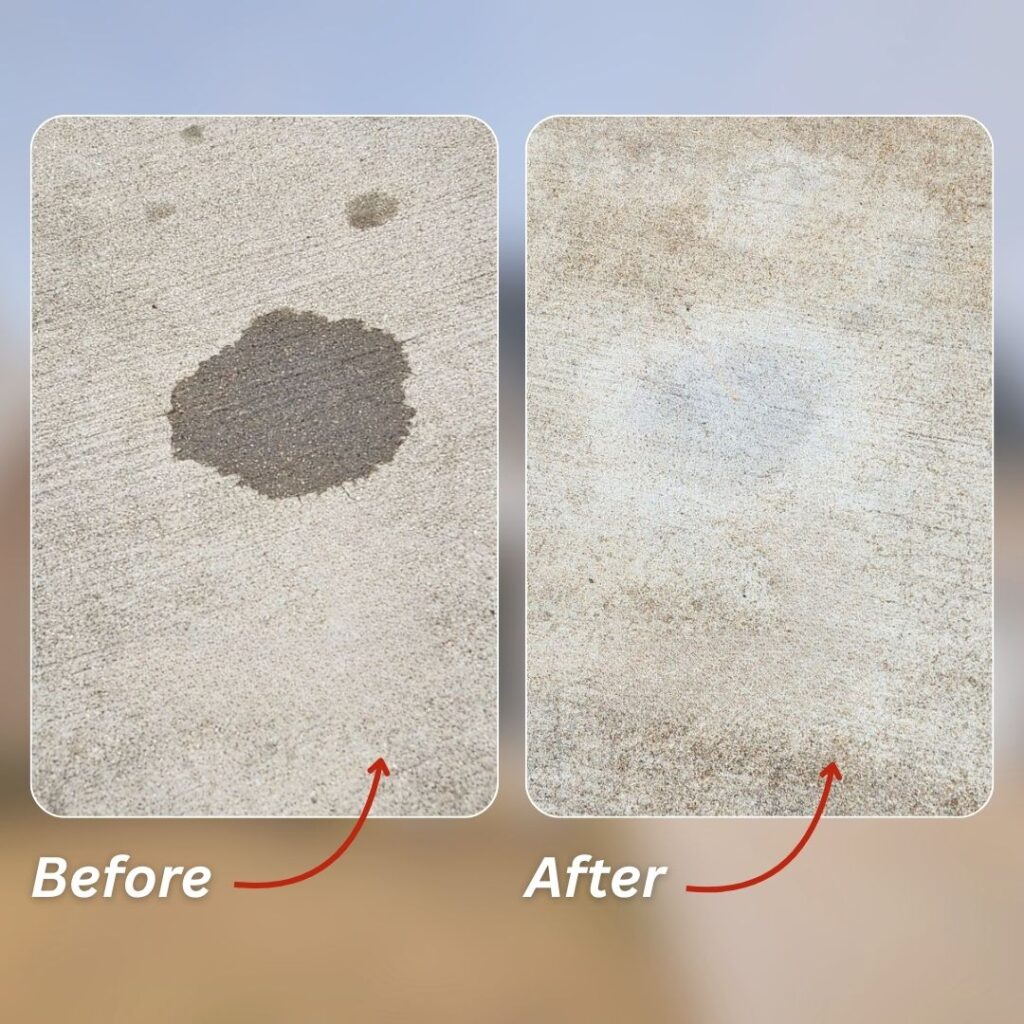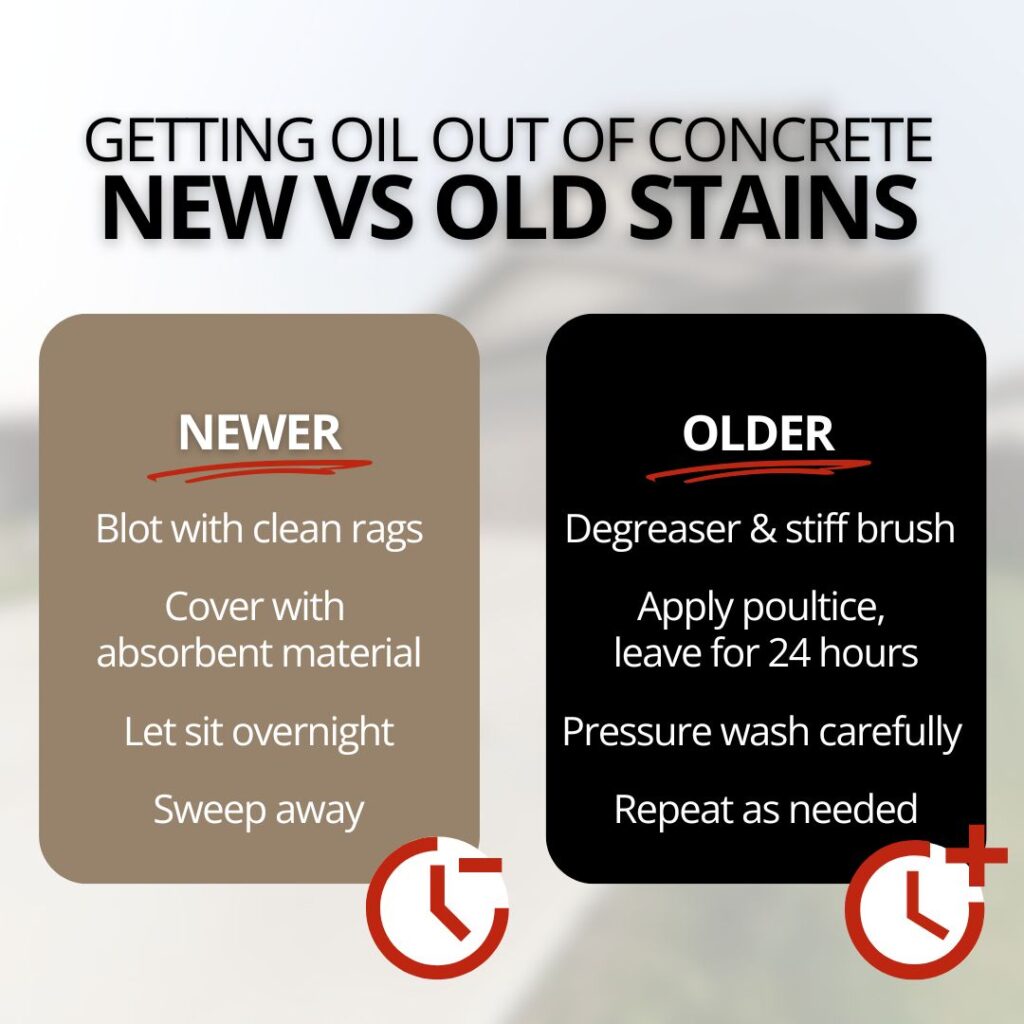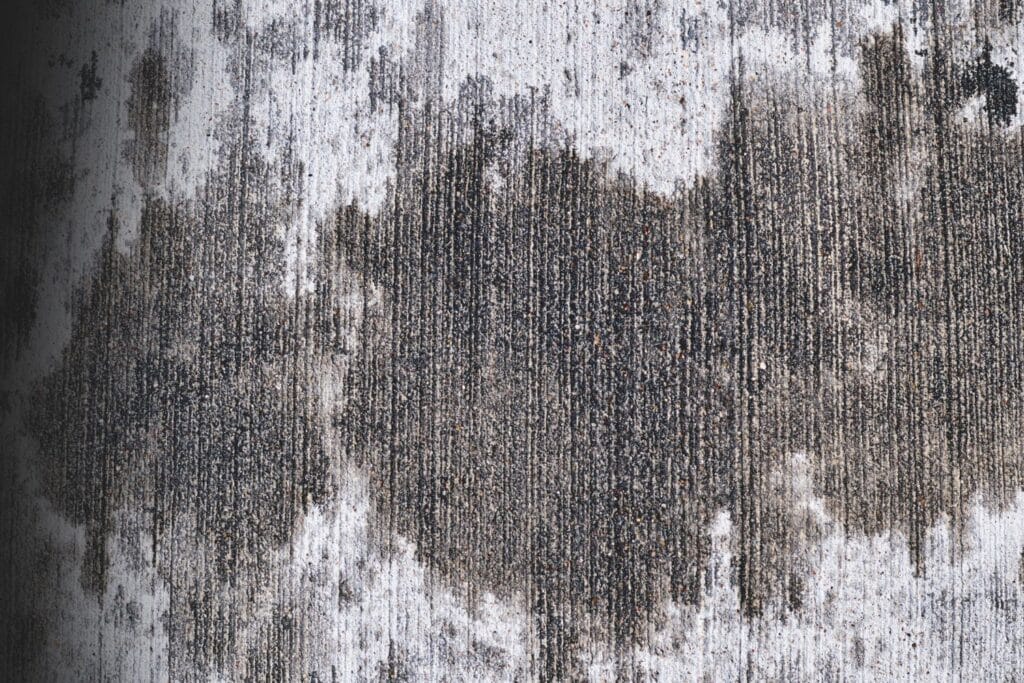If you’re facing oil stains on concrete that have been there for days, weeks, or even years, there are practical ways to improve the look of your floor or driveway. Understanding what works and when to call for professional help can make a big difference, especially if you are preparing to sell.
Concrete floors and driveways are designed to be durable, but when oil stains set in, they can affect both the appearance and value of a home. Whether the stains come from leaking vehicles, spilled fluids during maintenance, or lawn equipment, they often raise concerns during home inspections.
In Atlanta’s competitive housing market, first impressions matter. Curb appeal can influence buyers’ perception of the entire property and help homes sell faster.
Why Oil Stains Are a Problem
Concrete is a porous material. Oil penetrates into tiny spaces on the surface and spreads further over time. When this happens, the stain not only darkens but also becomes more difficult to remove. Oil-stained concrete can also create a slip hazard.
The National Floor Safety Institute reports that slippery surfaces, including those contaminated by oil, contribute to household falls and injuries.
For homebuyers, widespread or severe stains can signal a lack of maintenance, even if the property is structurally sound. During inspections, large stains near garages or driveways may prompt questions about potential leaks, surface damage, or drainage problems.

What to Do About Fresh vs Older Spills
If you catch a spill quickly, the goal is to prevent oil from soaking into the concrete. Place paper towels or clean rags on the area to absorb as much oil as possible. Be careful not to wipe or smear the oil, which can make the stain larger.
Next, cover the spot with an absorbent material such as baking soda, clay-based cat litter, or sawdust. Leave it in place for several hours or overnight, then sweep it up and dispose of it according to local waste guidelines.
Even if you miss the chance to act immediately, the stain can still be reduced or removed with the right methods.
When stains have been in place for a while, they require stronger cleaning efforts. This does not mean the stain is permanent, but it may take several attempts and the right materials.
1) Degreasers designed for concrete
Commercial degreasers formulated for concrete can break down the oil that has penetrated into the surface. These products are available at hardware stores and should be used according to the manufacturer’s instructions.
A stiff-bristled brush can help work the degreaser into the stain before rinsing.
2) Poultice treatments
A poultice combines an absorbent powder, such as diatomaceous earth or powdered laundry detergent, with a solvent or cleaner. This paste is applied to the stain, covered with plastic to slow drying, and left for 24 to 48 hours. The poultice draws oil out of the concrete.
After the waiting period, it is scraped away, and the area is rinsed clean.
3) Pressure washing with caution
While pressure washing can help clean the surface, it is not always the best solution for deep stains. Used incorrectly, it can push oil further into the concrete or damage the surface. If you use a pressure washer, it should be combined with degreasers or cleaning solutions for best results.
4) Multiple treatments may be necessary
Older stains often need to be cleaned more than once to see improvement. It is important to let the area dry between treatments so you can assess how much of the stain remains.

What Inspectors Look For
From an inspection point of view, oil stains are typically cosmetic, but they can hint at other concerns. A driveway or garage floor covered with oil stains might cause a buyer or agent to ask questions about vehicle maintenance, grading, or surface drainage.
According to the Building Science Corporation, standing fluids like water or oil can contribute to concrete deterioration by promoting freeze-thaw damage or chemical breakdown over time.
Inspectors may also look for cracks, pitting, or spalling that could indicate a need for repair beyond just surface cleaning. For sellers, addressing visible stains before listing helps create a cleaner, better-maintained appearance.
When to Call a Professional
Champia Real Estate Inspections helps identify concerns during a property inspection that could affect value, safety, or a home sale.
While we do not perform concrete cleaning or repair, our inspectors can help you recognize when stains or surface issues may need attention beyond basic cleaning.
You should consider hiring a cleaning or concrete specialist if:
• The stains are widespread or have resisted multiple cleaning attempts
• The concrete shows cracks, pitting, or surface damage in addition to staining
• The stained areas create a slip hazard or impact safety
• You are preparing to sell and want to address curb appeal concerns noted during inspection
Our team highlights these issues so you can take the right next steps and protect your investment.
Preventing Future Oil Stains
Prevention helps protect surfaces and supports a positive impression during inspections. While Champia does not provide cleaning services, we see how simple maintenance helps homeowners avoid bigger concerns.
• Clean up spills as soon as possible so oil does not soak into the concrete
• Place drip pans under vehicles or outdoor equipment that could leak
• Keep driveways and garage floors graded correctly to prevent pooling
• Consider sealing concrete every few years, as recommended by a concrete professional, to make future cleanup easier
These small steps can help keep visible surfaces looking well cared for, which is important during inspections and showings.
Conclusion
Oil stains on concrete can affect how buyers, agents, or inspectors view a property. By staying ahead of maintenance and addressing stains before they become a bigger concern, you help protect your home’s value and appeal.
Champia Real Estate Inspections provides thorough evaluations so you can make smart, informed decisions about your property.
